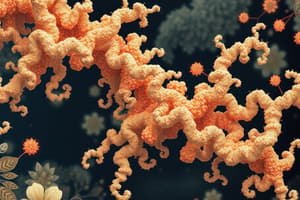Podcast
Questions and Answers
What is the primary role of casein micelles?
What is the primary role of casein micelles?
- To provide a source of lactose for fermentation
- To produce lactic acid during cheese making
- To transport calcium and phosphate to offspring (correct)
- To create a cloudiness in agar plates
What happens when lactic acid bacteria ferment lactose in milk?
What happens when lactic acid bacteria ferment lactose in milk?
- The milk becomes sweeter and thicker
- The milk turns into a solid state without whey
- Curds are formed and whey is produced (correct)
- Casein micelles dissolve completely
What is the result of the presence of extracellular proteolytic enzymes on casein agar plates?
What is the result of the presence of extracellular proteolytic enzymes on casein agar plates?
- A zone of proteolysis appears and the medium becomes clear (correct)
- The medium turns yellow and opaque
- The medium remains cloudy and unchanged
- The entire plate solidifies into cheese
What is whey in the context of cheese production?
What is whey in the context of cheese production?
Which statement is correct regarding casein's solubility in foods?
Which statement is correct regarding casein's solubility in foods?
Which of the following correctly identifies the four basic functions of proteins in living organisms?
Which of the following correctly identifies the four basic functions of proteins in living organisms?
What are the four levels of complexity of protein structure?
What are the four levels of complexity of protein structure?
What is the significance of proteases in microbial metabolism?
What is the significance of proteases in microbial metabolism?
How is casein utilized by casein protease in microbial metabolism?
How is casein utilized by casein protease in microbial metabolism?
What distinguishes chemoheterotrophic organisms from autotrophs?
What distinguishes chemoheterotrophic organisms from autotrophs?
Which statement accurately describes amino acids in protein synthesis?
Which statement accurately describes amino acids in protein synthesis?
What role do structural proteins play in living organisms?
What role do structural proteins play in living organisms?
What is the primary role of motility proteins in living cells?
What is the primary role of motility proteins in living cells?
Which structure is formed when amino acids interact to create a specific arrangement, including patterns like a-helices and β-sheets?
Which structure is formed when amino acids interact to create a specific arrangement, including patterns like a-helices and β-sheets?
What is the function of enzymes in living cells?
What is the function of enzymes in living cells?
What happens to enzymes when they are subjected to extreme temperature and pH levels?
What happens to enzymes when they are subjected to extreme temperature and pH levels?
What structural level of proteins involves the folding of the protein into a three-dimensional shape?
What structural level of proteins involves the folding of the protein into a three-dimensional shape?
Which type of proteins are involved in the immune response to foreign materials in higher organisms?
Which type of proteins are involved in the immune response to foreign materials in higher organisms?
Which statement about casein is correct?
Which statement about casein is correct?
What is required for microorganisms to utilize proteins as a carbon and energy source?
What is required for microorganisms to utilize proteins as a carbon and energy source?
What is the correct definition of quaternary structure in proteins?
What is the correct definition of quaternary structure in proteins?
How do extracellular peptidases and proteases assist microorganisms?
How do extracellular peptidases and proteases assist microorganisms?
Flashcards
Protein Functions
Protein Functions
Proteins have four main roles in living organisms: structural support, catalyzing reactions, transporting molecules, and regulating cell processes.
Protein Structure Levels
Protein Structure Levels
Proteins have four structural levels: primary (sequence of amino acids), secondary (folding into sheets or helices), tertiary (3D shape), and quaternary (multiple protein subunits).
Proteases
Proteases
Proteases are enzymes that break down proteins into amino acids.
Casein Protease
Casein Protease
Signup and view all the flashcards
Chemoheterotrophs
Chemoheterotrophs
Signup and view all the flashcards
Amino Acids
Amino Acids
Signup and view all the flashcards
Peptide bond
Peptide bond
Signup and view all the flashcards
Casein function
Casein function
Signup and view all the flashcards
Casein applications
Casein applications
Signup and view all the flashcards
Caseinate vs. Casein
Caseinate vs. Casein
Signup and view all the flashcards
Cheese formation process
Cheese formation process
Signup and view all the flashcards
Casein agar test
Casein agar test
Signup and view all the flashcards
Motility Proteins
Motility Proteins
Signup and view all the flashcards
Enzymes
Enzymes
Signup and view all the flashcards
Intracellular Enzymes
Intracellular Enzymes
Signup and view all the flashcards
Exoenzymes
Exoenzymes
Signup and view all the flashcards
Antibodies
Antibodies
Signup and view all the flashcards
Protein Primary Structure
Protein Primary Structure
Signup and view all the flashcards
Protein Secondary Structure
Protein Secondary Structure
Signup and view all the flashcards
Protein Tertiary Structure
Protein Tertiary Structure
Signup and view all the flashcards
Protein Quaternary Structure
Protein Quaternary Structure
Signup and view all the flashcards
Protein Degradation
Protein Degradation
Signup and view all the flashcards
Study Notes
Learning Objectives
- List and describe the four basic functions of proteins in living organisms
- Differentiate between the four levels of protein structure complexity
- Explain the importance of proteases in microbial metabolism
- Explain the biochemistry involved in casein utilization by casein protease
- Investigate casein utilization by environmental isolates
- Interpret results from casein agar plates
Introduction
- Studying an organism's structure, growth characteristics, and susceptibility to chemotherapeutics guides microbiologists to study biochemical/metabolic characteristics for identification
- Organisms adapt to their niche, including metabolic adaptations for nutrient utilization
- This exercise studies biochemical adaptations in microorganisms for identification
Proteins
- Proteins are the building blocks of organisms
- Proteins are classified by carbon/energy sources (heterotrophs/autotrophs) and by energy sources (chemicals/inorganic/sun)
- Environmental isolates are chemoheterotrophs
- Proteins are made of amino acids
- Amino acids are joined by peptide bonds
Casein Proteases
- Casein is a milk protein that gives milk its white color (approximately 80%)
- Casein exists in colloidal molecules called casein micelles
- Casein transports calcium and phosphate in mammals
- Casein is used in various food products (coffee/infant formulas)
- Cheese is made by fermenting milk sugar (lactose) with lactic acid bacteria
- Acidic environment from fermentation causes casein to coagulate, forming curds
- Whey is the liquid removed after curds are formed from cheese
- Microorganisms can break down proteins into smaller peptides and transport them for cellular use
Casein Agar Plates
- Cloudy/opaque plates result from adding milk to an agar preparation
- Spot inoculating microbes onto medium is used to test for casein protease/peptidase production
- Clear zones around microbial growth indicate protein breakdown
- Cloudy plates indicate no protein breakdown
Studying That Suits You
Use AI to generate personalized quizzes and flashcards to suit your learning preferences.
Related Documents
Description
This quiz focuses on the fundamental functions of proteins in living organisms, emphasizing their complexity and importance in microbial metabolism. Participants will explore the roles of proteases and investigate casein utilization in environmental microorganisms. Engage with questions that deepen your understanding of protein biochemistry and microbial adaptations.




